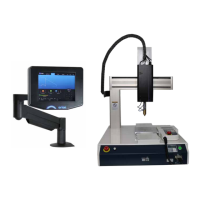39
GRINDING
• e electrode should be sharpened using the included diamond grinding wheel in a high speed
rotary tool.
• Hold the electrode at about a 15° angle off horizontal and spin the electrode between the thumb and
forefinger as it grinds.
• Make sure the diamond grains on the wheel are dragging across the electrode parallel to the length,
not perpendicular. is grinding technique allows the plasma to flow off the tip in a more uniform
manner during arc generation – leading to more uniform weld spots.
Gas Cone
e gas cone is the first point of contact the weld head will make with the parts to be welded. It acts as the
positive leg of the weld circuit and also applies pressure to the weld site to ensure good contact between
layers during the weld.
• Keep the tip of the gas cone as clean as possible. It is a good idea to check it during every electrode
change, since build up and contamination can minimize electrical contact and lead to weak welds or
missed actuations.
• A size 1 drill bit can serve to clean out the weld splash material from the inner diameter of the tip.
• 600 grit sand paper on a flat surface can serve to clean up the tip and remove any contamination. Be
sure to keep the cone level during the sanding process (if the tip is sanded on an angle, the electrical
contact could be minimized).
Metals
e size (shape and thickness), configuration, and alloys/types of metals can be highly influential on
successful welds.
SIZE/ CONFIGURATION
• Ideally, the two components being welded should be similar in thickness and size.
• If one of the components is thicker than the other, it is usually best to place the thinner component
on top.
• Some size combinations will be difficult to achieve.
• Very thick bottom with thin top will lead to blow outs on the top layer.
• Very thick top and bottom parts will not allow sufficient weld penetration.
• Sometimes a layer of copper can be penetrated with sufficiently high weld energies, but if the
bottom layer is too thin (some battery cans) the heat necessary to get through the copper will blow

